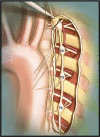Cardiac sympathetic denervation in the prevention of genetically mediated life-threatening ventricular arrhythmias
- PMID: 35301528
- PMCID: PMC9459868
- DOI: 10.1093/eurheartj/ehac134
Cardiac sympathetic denervation in the prevention of genetically mediated life-threatening ventricular arrhythmias
Erratum in
-
Corrigendum to: Cardiac sympathetic denervation in the prevention of genetically mediated life-threatening ventricular arrhythmias.Eur Heart J. 2022 Sep 1;43(33):3181. doi: 10.1093/eurheartj/ehac380. Eur Heart J. 2022. PMID: 35801806 Free PMC article. No abstract available.
Abstract
Proper management of patients affected by genetic disorders causing life-threatening arrhythmias is important for several reasons, including even societal ones, given the predominantly young age of those affected. Incorrect management often has dire consequences, ranging from unnecessary psychologic damage for the patients whose life becomes too limited by the fear of sudden death to equally avoidable tragedies when the entire armamentarium of effective therapies is not fully utilized. In this review, we focus primarily on long QT syndrome (LQTS) and catecholaminergic polymorphic ventricular tachycardia (CPVT) and deal specifically with the clinical impact of the most commonly used cardiac sympathetic denervation (CSD), namely left cardiac sympathetic denervation (LCSD). The two of us have used LCSD in the management of our patients with either LQTS or CPVT for a very long time and have been involved in ∼500 such interventions. It is on the basis of this personal and direct experience that we wish to share our views with clinical cardiologists and electrophysiologists, adult and paediatric, and with genetic cardiologists. We will begin by reviewing the history and rationale underlying sympathetic denervation therapy and will continue with a disease-specific intensification of therapy, and then with a discussion on how the impressive efficacy of LCSD should translate into guideline-directed therapy in both current and future guidelines, in order to upgrade the quality of care in the era of precision medicine.
Keywords: Cardiac sympathetic denervation; Catecholaminergic polymorphic ventricular tachycardia; Genetic disorders; Left cardiac sympathetic denervation; Long QT syndrome; Sudden cardiac death.
© The Author(s) 2022. Published by Oxford University Press on behalf of European Society of Cardiology. All rights reserved. For permissions, please e-mail: journals.permissions@oup.com.
Figures




Similar articles
-
Physical and Psychological Consequences of Left Cardiac Sympathetic Denervation in Long-QT Syndrome and Catecholaminergic Polymorphic Ventricular Tachycardia.Circ Arrhythm Electrophysiol. 2015 Oct;8(5):1151-8. doi: 10.1161/CIRCEP.115.003159. Epub 2015 Jul 29. Circ Arrhythm Electrophysiol. 2015. PMID: 26224781
-
Left thoracoscopic sympathectomy for cardiac denervation in patients with life-threatening ventricular arrhythmias.J Thorac Cardiovasc Surg. 2014 Jan;147(1):404-9. doi: 10.1016/j.jtcvs.2013.07.064. Epub 2013 Oct 24. J Thorac Cardiovasc Surg. 2014. PMID: 24268954
-
Left cardiac sympathetic denervation for the management of life-threatening ventricular tachyarrhythmias in young patients with catecholaminergic polymorphic ventricular tachycardia and long QT syndrome.Clin Res Cardiol. 2013 Jan;102(1):33-42. doi: 10.1007/s00392-012-0492-7. Epub 2012 Jul 21. Clin Res Cardiol. 2013. PMID: 22821214 Free PMC article.
-
Left cardiac sympathetic denervation in the management of long QT syndrome and catecholaminergic polymorphic ventricular tachycardia: A meta-regression.Congenit Heart Dis. 2019 Nov;14(6):1102-1112. doi: 10.1111/chd.12855. Epub 2019 Oct 16. Congenit Heart Dis. 2019. PMID: 31621201
-
Cardiac sympathetic denervation 100years later: Jonnesco would have never believed it.Int J Cardiol. 2017 Jun 15;237:25-28. doi: 10.1016/j.ijcard.2017.03.020. Epub 2017 Mar 8. Int J Cardiol. 2017. PMID: 28318666 Review.
Cited by
-
Implantable defibrillators in primary prevention of genetic arrhythmias. A shocking choice?Eur Heart J. 2022 Aug 21;43(32):3029-3040. doi: 10.1093/eurheartj/ehac298. Eur Heart J. 2022. PMID: 35725934 Free PMC article. Review.
-
Targeted ablation of the left middle cervical ganglion prevents ventricular arrhythmias and cardiac injury induced by AMI.Basic Res Cardiol. 2024 Feb;119(1):57-74. doi: 10.1007/s00395-023-01026-w. Epub 2023 Dec 28. Basic Res Cardiol. 2024. PMID: 38151579
-
Pt nanoshells with a high NIR-II photothermal conversion efficiency mediates multimodal neuromodulation against ventricular arrhythmias.Nat Commun. 2024 Jul 28;15(1):6362. doi: 10.1038/s41467-024-50557-w. Nat Commun. 2024. PMID: 39069566 Free PMC article.
-
Autophagy-enhanced nanosonosensitizer mediated sonodynamic therapy for post-myocardial infarction neuromodulation and arrhythmia prevention.Theranostics. 2025 Jan 13;15(6):2201-2214. doi: 10.7150/thno.103780. eCollection 2025. Theranostics. 2025. PMID: 39990226 Free PMC article.
-
Broad and narrow complex tachycardia resulting in cardiorespiratory arrest in a child: what is the optimal treatment strategy?Eur Heart J Case Rep. 2023 Oct 4;7(10):ytad490. doi: 10.1093/ehjcr/ytad490. eCollection 2023 Oct. Eur Heart J Case Rep. 2023. PMID: 37869737 Free PMC article.
References
-
- Lown B. Sudden cardiac death: the major challenge confronting contemporary cardiology. Am J Cardiol 1979;43:313–328. - PubMed
-
- Schwartz PJ. 1970–2020: 50 years of research on the long QT syndrome—from almost zero knowledge to precision medicine. Eur Heart J 2021;42:1063–1072. - PubMed
-
- Collura CA, Johnson JN, Moir C, Ackerman MJ. Left cardiac sympathetic denervation for the treatment of long QT syndrome and catecholaminergic polymorphic ventricular tachycardia using video-assisted thoracic surgery. Heart Rhythm 2009;6:752–759. - PubMed
-
- Schwartz PJ. Cutting nerves and saving lives. Heart Rhythm 2009;6:760–763. - PubMed

